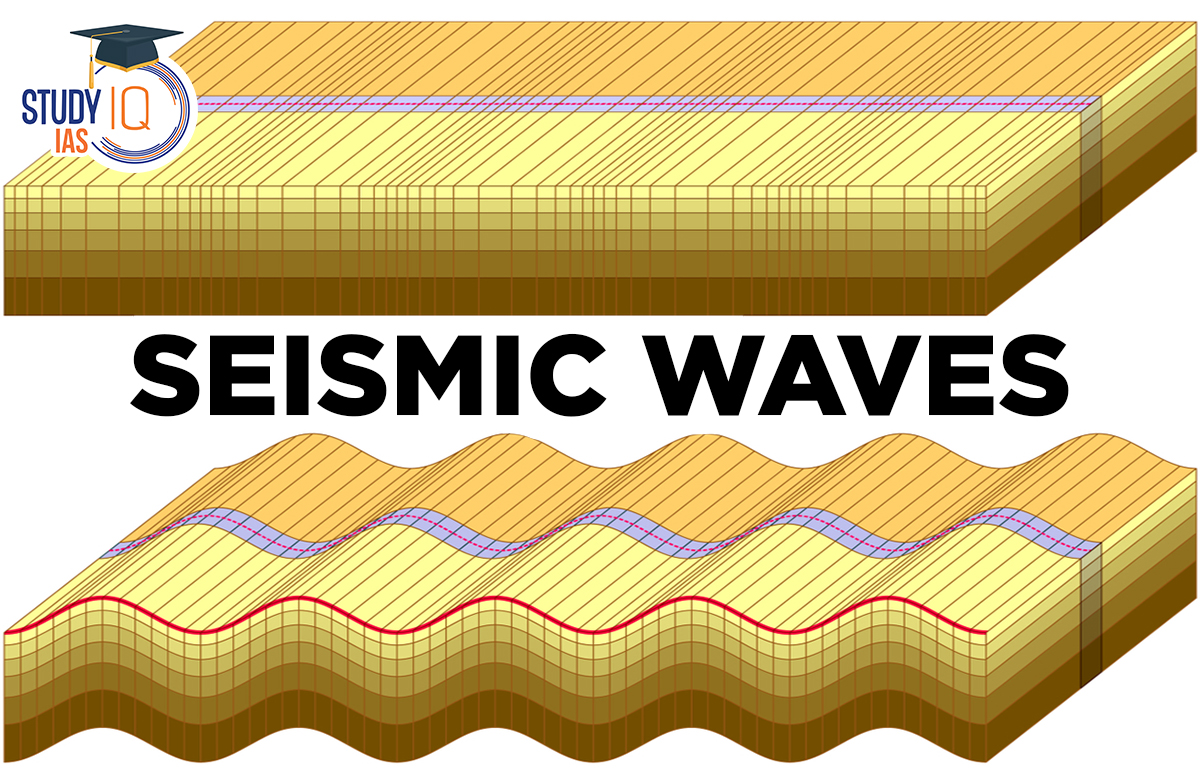Table of Contents
What are Seismic Waves?
Seismic Waves are caused by a sudden movement of materials within the Earth, such as a fault slip during an earthquake. An Earthquake is caused by the sudden release of energy built between techtonic plates This energy is released in the form of waves that travel throughout the earth’s interior. These waves generated by an earthquake are called seismic waves.
These seismic waves move through the Earth as vibrations. An instrument called a seismometer records and measures these vibrations. The seismometer creates a graph called a seismogram that shows the vibrations. These waves travel at different speeds through different materials. Scientists use this information to learn about the Earth’s inside structure.
Read More: Solstices and Equinoxes
Seismic Waves Types
Seismic Waves are broadly classified into two types
- Body waves
- Surface waves.
This classification is based on where seismic waves travel. Body waves start inside the Earth and move through its layers. When these waves hit the rocks on the surface, they create surface waves, which move along the Earth’s surface.
Read More: Milky Way Galaxy
Body Waves
The body waves are further divided into two types,
- Primary Waves,
- Secondary Waves.
They are called primary or secondary based on when they are recorded at the seismometer.
Primary Waves
These are the fastest seismic waves, traveling at 5 to 14 km per second. They are the first to reach the Earth’s surface, which is why they are called Primary waves or “P” waves. P waves move by compressing and expanding the material, pushing and pulling as they go. Because of this, they are also known as compressional waves. Particles move in the same direction as the wave.
Read More: Interior of Earth
Secondary Waves
S waves are the second fastest seismic waves, traveling through solids but not through liquids or gases. These waves travel slower than P waves, at about 3.5-7.2 km per second. They move up and down, which is why they are called transverse waves. They change the material they go through, so they are also known as shear waves. Secondary waves, or S waves, are a type of seismic body wave where rock particles move at right angles to the wave’s direction. These waves change the shape of the rocks they pass through.
Surface Waves
Surface waves are also called Long Period Waves or “L” waves because they travel the longest distances and are the last to reach the Earth’s surface. They only affect the surface and move in a sideways way, causing the most damage during an earthquake.
There are two types of surface waves:
Love waves:
Named after A.E.H. Love, a British mathematician. They are the fastest surface waves and move the ground side to side.
Rayleigh waves:
Named after Lord Rayleigh, who discovered them in 1885. These waves roll over the ground like ocean waves, making the ground move in a circular motion.
Seismic Waves Shadow Zones
If the Earth had the same materials everywhere, the waves would go in straight lines. But they don’t. They bounce off and bend as they move through the Earth.
Here is what we found out from the waves:
- P waves are the first waves we see on a seismometer.
- P waves travel through the entire Earth.
- No P waves are detected between 105 degrees and 145 degrees from where an earthquake starts.
- After 140 degrees, P waves are recorded again.
- S waves show up after P waves.
- No S waves are recorded between 105 degrees and 145 degrees.
- S waves do not return at all.
- From this information, scientists figured out that the outer core is liquid because S waves can’t pass through it. Beyond 145 degrees, P waves reappear and move faster, indicating that the inner core is solid.
The area where no seismic waves are detected is called the shadow zone.
Comparison Among Primary, Secondary & Surface Seismic Waves
Below is the comparison of Primary, Secondary & Surface Seismic Waves:
| Criteria | Primary Waves | Secondary Waves | Surface Waves |
| Time to reach the Earth’s Surface | They are the first to strike the crust of the earth. | After the primary wave, the secondary wave reaches the earth’s crust. | Reach the earth’s crust last. |
| Wavelength | The wavelength is very short in nature. | The wavelength is of medium size. | The wavelength is the longest in size. |
| Direction | It strikes a parallel direction on the structure of rock where tremor occurs. | It strikes at a right angle. Hence it acts obliquely. | It also acts obliquely. |
| Movement through Different Materials | They can move through solid, liquid and gaseous | It can move only through solid substances. | It can move only through solid materials. |
| Speed | It has the highest speed- about 5 to 14 km per second. | The speed is lower than the ‘P’ wave- 3.5-7.2 km per second. | It moves slower than ‘P’ and ‘S’ waves- about 3 to 5 km per second. |
Seismic Waves Disaster
Seismic Waves cause disasters named Tsunamis. Tsunamis are oceanic gravity waves caused by geological processes such as earthquakes, landslides, or Volcanic Eruptions. Large shallow earthquakes along subduction zones cause the majority of tsunamis. Tsunami is a Japanese word that means “harbour wave,” and it is also known as a seismic sea wave or, incorrectly, a tidal wave.
Tsunamis are usually small and unnoticed in the deep sea, but they grow large and cause damage when they approach coasts or harbours. The 2004 Indian Ocean tsunami demonstrated that a tsunami can travel trans-oceanic distances and cause damage far from its source.
Seismic Waves UPSC
In simple terms, an earthquake is the shaking of the earth. It is a natural occurrence. It is caused by the release of energy, which causes waves to propagate in all directions.
Seismic waves are vibrations generated by earthquakes as they travel through the Earth and are recorded on seismographs.
The hypocenter is the location beneath the earth’s surface where the earthquake begins, and the epicentre is the location directly above it on the earth’s surface.
A UPSC aspirant should be well versed in the topic of Seismic Waves and Types from both Prelims and Mains points of View. The details in the article would help candidates prepare for UPSC 2023.


 Desert Climate, Distribution, Climatic C...
Desert Climate, Distribution, Climatic C...
 Deserts of India Map, Features of Thar D...
Deserts of India Map, Features of Thar D...
 Indus Valley Civilization, History, Phas...
Indus Valley Civilization, History, Phas...





















